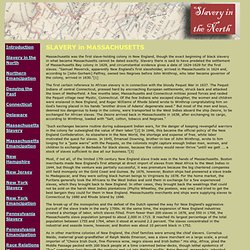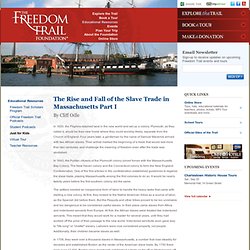

10 Things You May Not Know About the Puritans. James Purefoy as the buckle-hatted Puritan Solomon Kane in ‘Solomon Kane’ (Pic: Optimum) As we look towards Thanksgiving, here are a few interesting facts about those plucky English settlers who established the second major settlement in North America, and what customs, traditions and other cultural baggage they brought with them into the new world.

PURITAN HISTORY, PAST, PRESENT AND FUTURE. In this series of articles, (see the subject headings below left), we shall be going on a journey.

It will take us back 500 years into time. We shall be taking a look at the extraordinary history of the Puritans.
Wp-content/uploads/2013/02/Racism-and-Slavery-in-Puritan-New-England.pdf. Reviews. Reviews. Slavery in Massachusetts. Massachusetts was the first slave-holding colony in New England, though the exact beginning of black slavery in what became Massachusetts cannot be dated exactly.

Slavery there is said to have predated the settlement of Massachusetts Bay colony in 1629, and circumstantial evidence gives a date of 1624-1629 for the first slaves. "Samuel Maverick, apparently New England's first slaveholder, arrived in Massachusetts in 1624 and, according to [John Gorham] Palfrey, owned two Negroes before John Winthrop, who later became governor of the colony, arrived in 1630. "[1] The first certain reference to African slavery is in connection with the bloody Pequot War in 1637. The Freedom Trail Foundation - Educational Resources. By Cliff Odle In 1620, the Pilgrims reached land in the new world and set up a colony.

Plymouth, as they called it, would be their new home where they could worship freely, separate from the Church of England. Four years later, a gentleman by the name of Samuel Maverick arrived with two African slaves. Colonial Life. When is Thanksgiving? Colonizing America: Crash Course US History #2. 19th century Earthly Utopias. In the 19th century, at a time of massive industrial growth, Robert Owen and Titus Salt, both industrialists and reformers, set up model communities to house the workers at their textile mills.

These experimental communities are often referred to as socialist utopias. American Passages - Unit 3. Utopian Promise: Authors. Authors: Anne Bradstreet (c. 1612-1672) Anne Bradstreet was born in England in 1612 to well-connected Puritan parents.

Her father, Thomas Dudley, was unusual in his commitment to teaching his daughter literature, history, and philosophy, and Bradstreet benefited from an extensive classical education such as was usually reserved only for male children. Her sixty years of life were troubled by recurring sickness and ill health, beginning with an attack of smallpox when she was sixteen. Anne Bradstreet. Anne Bradstreet was the first woman to be recognized as an accomplished New World Poet.

Her volume of poetry The Tenth Muse Lately Sprung Up in America ... received considerable favorable attention when it was first published in London in 1650. Eight years after it appeared it was listed by William London in his Catalogue of the Most Vendible Books in England, and George III is reported to have had the volume in his library. Bradstreet's work has endured, and she is still considered to be one of the most important early American poets. Index to Anne Bradstreet. "A frontier is no friendly place for literary creation; yet within a year after landing with John Winthrop in Massachusetts, America's first English poet was writing, and the fruits of her pen from the next forty odd years remain with us today," according to Jeannine Hensley, the editor of her Works.

Hensely goes on to say, "she was not a great poet, but her poetry has endured. " It has endured because of the personal intensity and poignancy of her writings, borne out of hard experience and faith. Anne Bradstreet Study Materials. Building Jamestown and Conflicts Among the Colony's Leaders - For Teachers. After the June 1607 departure of Captain Newport, who returned to England to gather supplies and additional colonists, those left in Virginia faced a difficult time.

According to this excerpt from John Smith's Generall Historie of Virginia, what were the most significant problems the Virginia colonists faced in this period? What is John Smith's view of the colony's leaders at this time? BEing thus left to our fortunes, it fortuned that within ten dayes scarce ten amongst us could either goe, or well stand, such extreame weaknes and sicknes oppressed us. "A Devil to Tempt and a Corrupt Heart to Deceive," John Dane Battles Life's Temptations, ca. 1670s.
John Dane, a tailor, was born in Berkhampstead, England, around 1612.

In the late 1630s, which he recollects here as a period of “a great coming to New England,” he and his family emigrated to Ipswich, Massachusetts. He died in Ipswich in 1684. Dane’s parents, like many Puritan parents, raised their children to carry what historian Philip Greven calls an “inner disciplinarian” within their own consciences at all times. Dane’s mother reminded him: “Go where you will, God will find you out.” Puritans video 3:52. Pilgrims Home. A group of investors called the Merchant Adventurers helped the Separatists pay for their journey. They gave them food, supples, and a ship--the Mayflower--in exchange for anything valuable that they found in America.
All Aboard! On September 16, 1620, the Mayflower set sail for America. 102 passengers had a long journey a head of them. The voyage lasted 66 days. Pilgrims Home. During their journey, the passengers on the Mayflower ate mostly cold, dry food. Ship's biscuits, made from flour and water, were plentiful but hard as rocks. They ate a lot of dried vegetables and salted meat because they did not spoil quickly. The passengers also brought boxes of spices. They would add the spices to their food to cover up the rotten taste.
Puritanism — History.com Articles, Video, Pictures and Facts. The roots of Puritanism are to be found in the beginnings of the English Reformation. The name “Puritans” (they were sometimes called “precisionists”) was a term of contempt assigned to the movement by its enemies. Although the epithet first emerged in the 1560s, the process through which Puritanism developed had been initiated in the 1530s, when King Henry VIII repudiated papal authority and transformed the Church of Rome into a state Church of England. Colonial America, 1607-1783. All American >Colonial America People Jonathan Edwards Anne Hutchinson William Penn Gilbert Tennent John Wesley George Whitefield Roger Williams John Winthrop Places. Documents in Law, History and Diplomacy.
VocabGrabber. Unit 2: Colonial. Puritanism in New England. Puritanism. Puritanism started in the sixteenth century as a movement to reform the Church of England. Background on Puritan Theology. Apocalypticism Explained. What did the Puritans think about God's ancient promises to Israel, and how they fit into that?